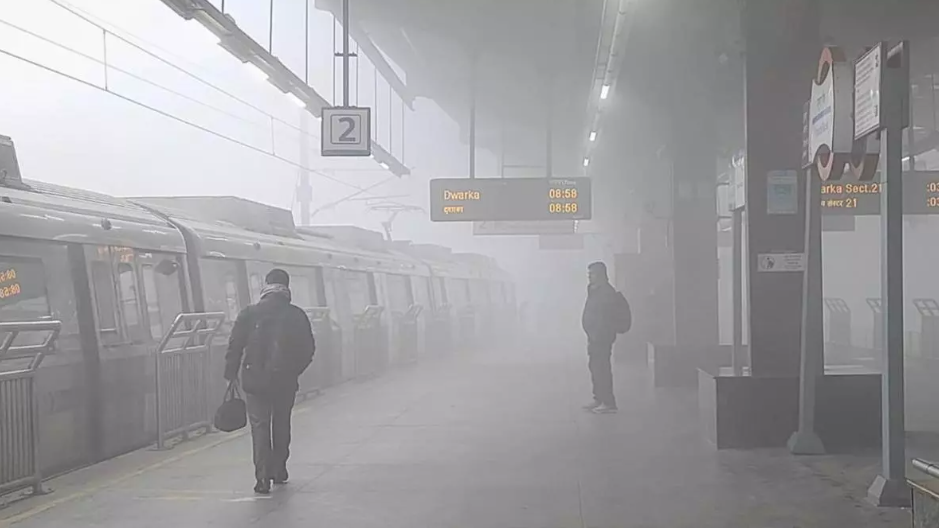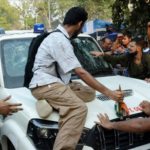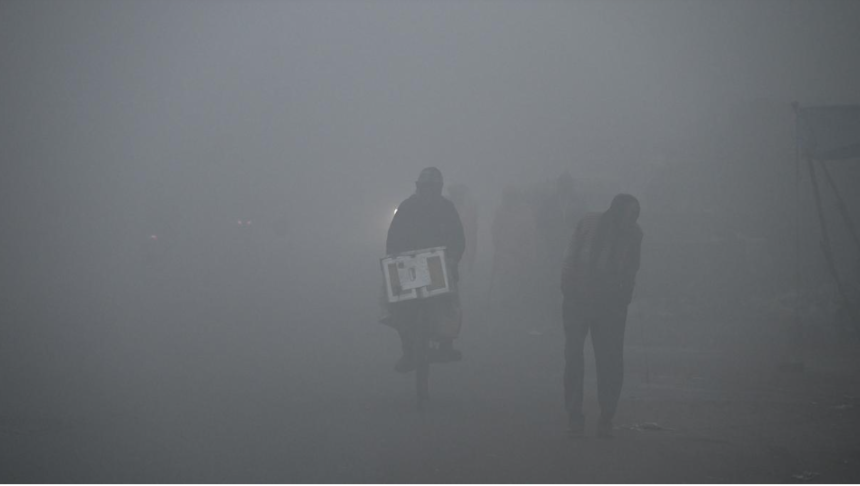Introduction
Dense Fog Envelops Delhi i continues to grapple with the challenges of winter, a dense fog blanketed parts of the national capital on Wednesday, causing widespread disruption to transportation services. Train and flight operations were severely impacted, with 47 trains delayed and several flights affected due to reduced visibility at the Indira Gandhi International (IGI) Airport and New Delhi railway station.
While the heavy fog led to inconveniences for passengers, there was a silver lining: Delhi’s Air Quality Index (AQI) showed significant improvement, offering some relief from the hazardous pollution levels that have plagued the region for weeks. This article delves into the impact of the fog on daily life, transportation services, and the correlation between fog and air quality in Delhi.
Transportation Disruptions Due to Dense Fog
Delhi woke up to extremely low visibility conditions as the temperature dipped further, typical of the winter season in northern India. The dense fog disrupted transportation services across the city, affecting thousands of commuters, travelers, and logistics operations.  For the more information click on this link
For the more information click on this link
1. Impact on Train Services
Train operations were severely hampered, with as many as 47 trains delayed as they struggled to navigate through the dense fog that drastically reduced visibility. According to railway officials, trains arriving from neighboring states, including Punjab, Haryana, Uttar Pradesh, and Rajasthan, faced delays of up to five hours at New Delhi railway station.
“Visibility on the tracks was less than 50 meters in the early hours of the morning,” said a railway spokesperson. “Our first priority is to ensure safety, and hence, train speeds were reduced across affected routes.”
Passengers at New Delhi railway station reported long hours of waiting, with many expressing frustration over the lack of real-time updates.
- A traveler, Ravi Kumar, who was waiting to board a delayed train to Kanpur, said, “I’ve been at the station for over three hours now. The fog is so dense that we can barely see the train tracks.”
- Another commuter, Sneha Verma, lamented, “There are hardly any announcements, and the cold weather makes the wait even more uncomfortable.”
2. Flight Operations Disrupted
At IGI Airport, the dense fog had a cascading effect on flight schedules, with several flights delayed and a few flights diverted to other airports.
Aviation officials confirmed that low-visibility protocols (LVP) were initiated during the early hours, requiring pilots to rely heavily on advanced Instrument Landing Systems (ILS). Despite this, some flights could not operate as scheduled due to fog density.
- Passengers reported delays ranging from 30 minutes to two hours.
- Some international flights arriving from Europe and the Middle East were forced to hold or divert to alternative airports until conditions improved.
The situation improved slightly by late morning, allowing airport authorities to resume operations for most flights. However, officials warned of potential fog-related delays over the next few days as weather patterns indicate similar conditions.
Delhi Weather Update: Severe Fog and Poor Visibility
The dense fog in Delhi is a result of a combination of factors, including low temperatures, high humidity, and weak wind movement. The India Meteorological Department (IMD) issued warnings of “very dense fog” across parts of northern India, with visibility dropping to as low as 20-50 meters in some areas.
Dr. Kuldeep Srivastava, head of the Regional Weather Forecasting Centre (RWFC), explained,
“The phenomenon of dense fog occurs during winter months when temperatures plummet and moisture levels are high. Weak wind conditions prevent the dispersion of water droplets, which aggregate to form thick fog.”
Temperatures Dip Further
The minimum temperature in Delhi dropped to 6°C on Wednesday morning, contributing to the intensification of fog. The combination of chilly weather and fog also created challenging conditions for motorists and pedestrians.
Impact on Road Transport
The dense fog also led to a surge in traffic congestion and accidents, with the Delhi Traffic Police issuing advisories for commuters to exercise caution while driving.
- Major traffic snarls were reported on key routes, including the Delhi-Gurugram Expressway, Outer Ring Road, and NH-44, as vehicles struggled to navigate with limited visibility.
- The use of fog lights became mandatory for vehicles traveling on highways and expressways.
- According to police reports, there were over 50 minor accidents recorded during the early hours, primarily due to poor visibility and lack of adherence to traffic rules.
A senior Delhi Traffic Police official said,
“Drivers are urged to maintain lower speeds, avoid sudden braking, and use fog lights. Those commuting for essential reasons are advised to plan extra time for travel due to reduced speeds and congestion.”
Air Quality Index (AQI) Improves
While the fog caused disruption to transportation, one noticeable benefit was the improvement in Delhi’s Air Quality Index (AQI), which fell to “moderate” levels for the first time in weeks.
- The AQI reading for Delhi on Wednesday morning ranged between 150-200, marking a significant departure from the “severe” category readings exceeding 400, seen throughout December.
- Several monitoring stations across the city reported improved air quality, with areas like Lodhi Road, Dwarka, and Anand Vihar witnessing a dramatic drop in pollutant concentrations.
Fog and AQI: The Connection
The improvement in AQI can be attributed to meteorological factors, including the settling of airborne pollutants in the form of fog droplets and reduced vehicular and industrial activity during peak fog conditions. While this provides short-term relief, environmentalists caution that the respite may be temporary.
Sunita Narain, director of the Centre for Science and Environment (CSE), remarked,
“Fog gives the illusion of cleaner air by reducing pollutant concentrations in the upper layers of the atmosphere. However, unless significant steps are taken to curb emissions, these pollutants will resurface once fog conditions subside.”
Safety Measures Issued by Authorities
With dense fog expected to persist, various government and local agencies have issued guidelines to ensure public safety:
- Advisory for Commuters
- Avoid non-essential travel during early morning and late-night hours when fog is at its peak.
- Use fog lights or low-beam headlights to increase visibility.
- Maintain sufficient distance between vehicles to prevent collisions.
- Flight and Train Travelers
- Passengers are advised to check for real-time updates on flight and train schedules.
- Airports and railway stations have increased announcements and helpline assistance for delayed travelers.
- Health Precautions
- Vulnerable groups such as the elderly, children, and those with respiratory issues are advised to stay indoors to avoid the combined effects of fog and cold air.
- Use air purifiers at home and wear masks if stepping outdoors to minimize exposure to pollutants trapped in fog droplets.
Voices from Affected Passengers
With delays and disruptions affecting thousands of passengers, travelers shared their experiences while waiting at train stations and airports:
- Arun Sharma, a businessman traveling to Lucknow for an important meeting, said,
“My train has been delayed by over three hours. These delays are understandable given the fog, but the lack of updates at the railway station adds to our frustration.” - Neha Sood, a frequent flyer from Delhi, commented on her delayed flight, saying,
“The airport staff have been helpful, but passengers are panicked. Delays during winter months are becoming increasingly frequent—it’s something the authorities need to address with better technology.”
Technological Efforts to Mitigate Delays
The disruption caused by dense fog has reignited discussions around adopting cutting-edge technology to minimize delays during winter months.
Advanced Air Navigation
The Instrument Landing System (ILS) is already in place at IGI Airport, allowing planes to operate safely in low-visibility conditions. Delhi Airport’s CAT III-B ILS is capable of supporting landings with visibility as low as 50 meters, among the best in the world. However, frequent disruptions indicate the need for better coordination between airlines and air traffic control.
Smart Railway Systems
Indian Railways has implemented anti-fog LED lights on locomotives and advanced signaling systems to help train drivers operate safely during fog. However, a more robust technological overhaul may be necessary to reduce fog-related delays.  For the more information click on this link
For the more information click on this link
Future Predictions: What to Expect
According to meteorologists, dense fog conditions are expected to persist over the next 2-3 days due to stagnant weather patterns in northern India. The IMD has predicted a gradual improvement in visibility as the week progresses, but commuters and travelers should brace for continued disruptions during early morning hours.
Environmental experts warn that a long-term solution to mitigate fog-related problems lies in addressing vehicular and industrial pollution, which exacerbates the formation of fog and smog layers.
Conclusion
The dense fog blanketing parts of Delhi on Wednesday disrupted daily life, with widespread delays in train and flight operations, traffic snarls, and road accidents. As passengers endured frustrating delays, the city received temporary respite with improved AQI levels, offering a glimmer of hope in its ongoing battle against pollution.
While dense fog is a recurring phenomenon in northern India during winter, this year’s disruptions highlight the importance of investments in better infrastructure, communication systems, and public awareness to minimize its impact. As Delhi braces for a few more days of fog, it remains a stark reminder of the delicate balance between nature and human activity. ALSO READ:-ISRO Successfully Demonstrates Restarting of Vikas Liquid Engine: A Key Step in Advancing Space Technology 2025





